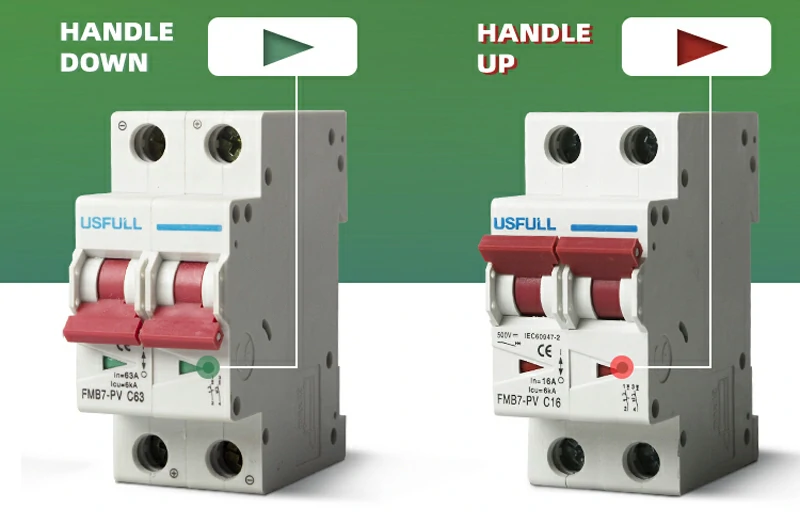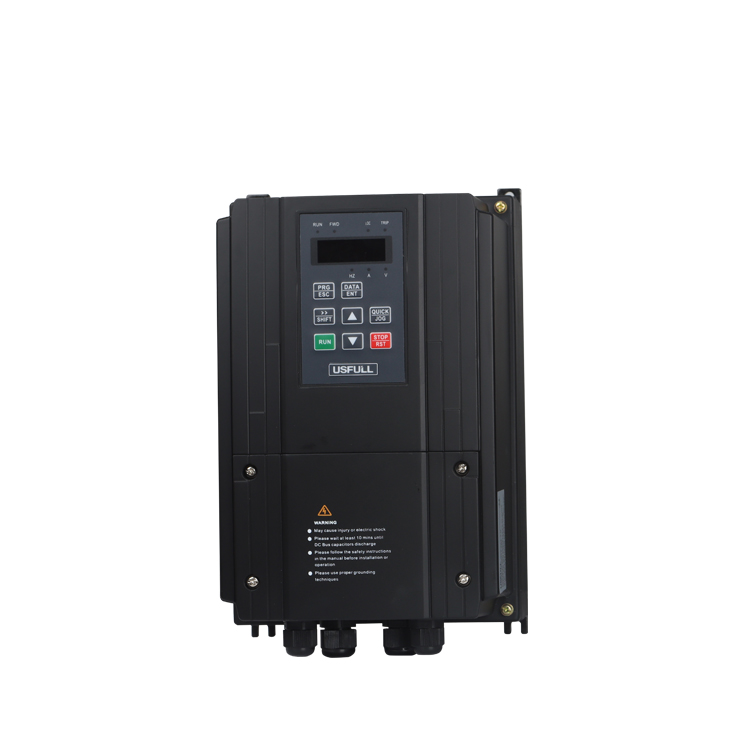¿Qué son los disyuntores de CC?
A Disyuntor de CC es un dispositivo de protección diseñado para interrumpir y controlar el flujo de corriente continua (CC) dentro de un sistema eléctrico. Cumplen la misma función básica que Disyuntores de CA sino que están diseñados específicamente para las características únicas de los circuitos de CC.
Disyuntores de CC se encargan de proteger los circuitos y aparatos eléctricos de sobrecargas, cortocircuitos y otras condiciones anormales que puedan causar daños o peligro. Cuando se detecta un fallo o una condición anormal, se activa un Disyuntor de CC abre el circuito, impidiendo el paso de la corriente y evitando daños mayores.

¿Cómo funcionan los disyuntores de CC?
A Disyuntor de CC funciona controlando la corriente que circula por un circuito e interrumpiéndola si se detectan condiciones anormales, como una sobrecarga o un cortocircuito. He aquí una visión general de cómo Disyuntores de CC trabajo:
Medida actual:
A Disyuntor de CC tiene un mecanismo de detección de corriente (normalmente un solenoide o un transformador de corriente) que supervisa continuamente la corriente que circula por el circuito. Un elemento sensor de corriente genera una señal proporcional basada en la magnitud de la corriente.
Unidad de disparo:
La señal procedente del mecanismo de detección de corriente se envía a la unidad de disparo, un dispositivo de protección integrado en el disyuntor. Una unidad de disparo analiza la señal de corriente y la compara con umbrales o características predefinidos.
Detección de fallos:
Una unidad de disparo supervisa continuamente la señal de alimentación para detectar condiciones anormales como sobrecargas, cortocircuitos y fallos a tierra. Una unidad de disparo detecta una condición de fallo cuando la corriente supera un umbral predefinido o se desvía de su valor esperado.
Señal de disparo:
La unidad de disparo genera una señal de disparo cuando se detecta una condición de fallo. Esta señal de desconexión se envía al disyuntor y activa la apertura de los contactos.
Apertura de contactos:
En Disyuntor de CC El mecanismo de actuación abre los contactos en respuesta a la señal de disparo. Esta acción interrumpe físicamente el flujo de electricidad y desconecta el circuito defectuoso del suministro eléctrico.
Extinción de arcos:
Cuando los contactos se separan, el flujo de corriente se interrumpe y puede producirse un arco entre ellos. Disyuntores de CC utilizan diferentes métodos de extinción del arco para extinguirlo rápidamente y evitar que vuelva a encenderse. Estos métodos pueden incluir bobinas de descarga magnética, cámaras de escape u otros mecanismos de extinción del arco.
Interrupción del suministro eléctrico:
Cuando se extingue el arco, el disyuntor mantiene los contactos en posición abierta, asegurando que el circuito roto permanezca aislado. Esto impide el flujo de corriente hasta que se despeje el fallo o el disyuntor se restablece manualmente.
Reiniciar y cerrar:
Una vez corregido el fallo, el disyuntor pueden rearmarse manualmente cerrando los contactos. Pueden utilizarse mecanismos de rearme manual o automático, dependiendo de el disyuntor diseño.
Es importante tener en cuenta que los distintos tipos de disyuntores de CC pueden tener diferentes principios de funcionamiento y tecnologías específicas. Sin embargo, el principio general es el mismo: detectar condiciones de corriente anormales e interrumpir el flujo de corriente para proteger el circuito y los dispositivos conectados.
Ventajas del disyuntor de CC:
Disyuntores de CC tienen varias ventajas sobre los disyuntores de CA en determinadas aplicaciones. Disyuntores de CC tienen las siguientes ventajas:
1. Mejora de la extinción del arco:
Disyuntores de CC están diseñados para manejar y extinguir los arcos de CC con mayor eficacia. Los arcos de CC suelen ser más difíciles de extinguir que los de CA porque los sistemas de CC no tienen un punto de cruce por cero. Disyuntores de CC disponen de un mecanismo especial de extinción del arco: B. Bobina de extinción magnética para extinguir rápidamente el arco y evitar que vuelva a encenderse.
2. Baja caída de tensión:
Los disyuntores de CC suelen tener una menor caída de tensión a través de los contactos en comparación con los disyuntores de CA. Esto es beneficioso en aplicaciones en las que la estabilidad de la tensión es crítica, ya que minimiza la pérdida de potencia y permite un control más preciso del sistema de CC y de las conexiones de los disyuntores de CC.
3. Reducción del tiempo de respuesta:
Los disyuntores de CC suelen tener un tiempo de respuesta más rápido que los de CA. Dado que los sistemas de CC no tienen puntos de cruce por cero, los fallos se pueden detectar y eliminar más rápidamente, lo que proporciona una protección más rápida contra cortocircuitos y otras condiciones anormales.
4. Tamaño compacto:
Disyuntores de CC son más compactos y ligeros que los disyuntores de CA con la misma corriente nominal. Esto se debe a que los sistemas de CC suelen tener dimensiones más reducidas y menos componentes para funcionar.
5. 5. Mayor selectividad:
A Disyuntor de CC puede mejorar la selectividad. En otras palabras, en caso de avería, sólo se aísla la sección defectuosa del circuito, sin afectar al resto. Este funcionamiento selectivo minimiza el tiempo de inactividad y las interferencias en los sistemas de CC conectados.
6. Compatibilidad con fuentes de alimentación y cargas de CC:
Disyuntores de CC están diseñados específicamente para manejar las características de las fuentes y cargas de corriente continua. Puede interrumpir y controlar la corriente continua sin las limitaciones de los disyuntores de corriente alterna optimizados para corriente alterna.
7. Aspectos de seguridad:
Disyuntores de CC puede proporcionar funciones de seguridad avanzadas como: B. Detección de fallos de arco, protección contra fallos a tierra, protección contra sobrecargas. Estas características ayudan a garantizar el funcionamiento seguro y la protección de los sistemas de alimentación de CC y sus dispositivos conectados.
Los beneficios de Disyuntores de CC son más relevantes para los sistemas de alimentación de CC, como los disyuntores de CC de energías renovables para sistemas fotovoltaicos, los disyuntores de CC para sistemas de baterías, los disyuntores de CC para vehículos eléctricos y determinadas aplicaciones industriales. Es importante tener en cuenta que Los disyuntores de CA siguen siendo la opción por defecto en la alimentación tradicional dominada por CA.



